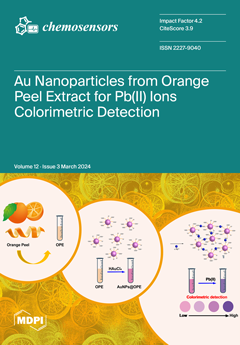Gold nanoparticles (AuNPs) were prepared by using a green approach that employed orange (citrus sinensis) peel water extract (OPE) as a reducing agent. In this case, the organic compounds present in orange peel were able to reduce Au(III) to Au(0) and, at the
[...] Read more.
Gold nanoparticles (AuNPs) were prepared by using a green approach that employed orange (citrus sinensis) peel water extract (OPE) as a reducing agent. In this case, the organic compounds present in orange peel were able to reduce Au(III) to Au(0) and, at the same time, to act as a capping agent, functionalizing the surface of the AuNPs, stabilizing them in a water solution. This “green” approach valorizes orange peel waste as a resourceful material and makes the synthetic process of AuNPs more environmentally sustainable, safe, and economically feasible than the traditional methods. The obtained gold nanoparticles (AuNPs@OPE) were characterized by FT–IR, DLS, SEM analysis, and UV–Vis spectroscopy; the latter showed a characteristic surface plasmon resonance (SPR) band at 530 nm, typical of spherical gold nanoparticles. The AuNPs@OPE were then tested as colorimetric sensors for heavy metals in water, showing an affinity and selectivity toward Pb
2+. In fact, in the presence of Pb
2+, the added cation favors the aggregation process, and, in this case, nanoparticles form clusters due to the interactions between Pb
2+ and the carboxyl/hydroxyl groups on the surface of the AuNPs@OPE, increasing the size of the nanostructure. This process is accompanied by a change in color of the AuNPs@OPE from pink to violet, with a formation of a second, new SPR band, at a higher wavelength, relative to the aggregate formation. The colorimetric assay was tested at different times with the addition of Pb
2+ ions showing different LOD values of 13.31 µM and 0.05 µM after 15 min and 90 min, respectively. The proposed colorimetric assay was also tested for analyzing Pb
2+ in drinking water samples demonstrating the reliability to use AuNPs@OPE with real samples.
Full article





